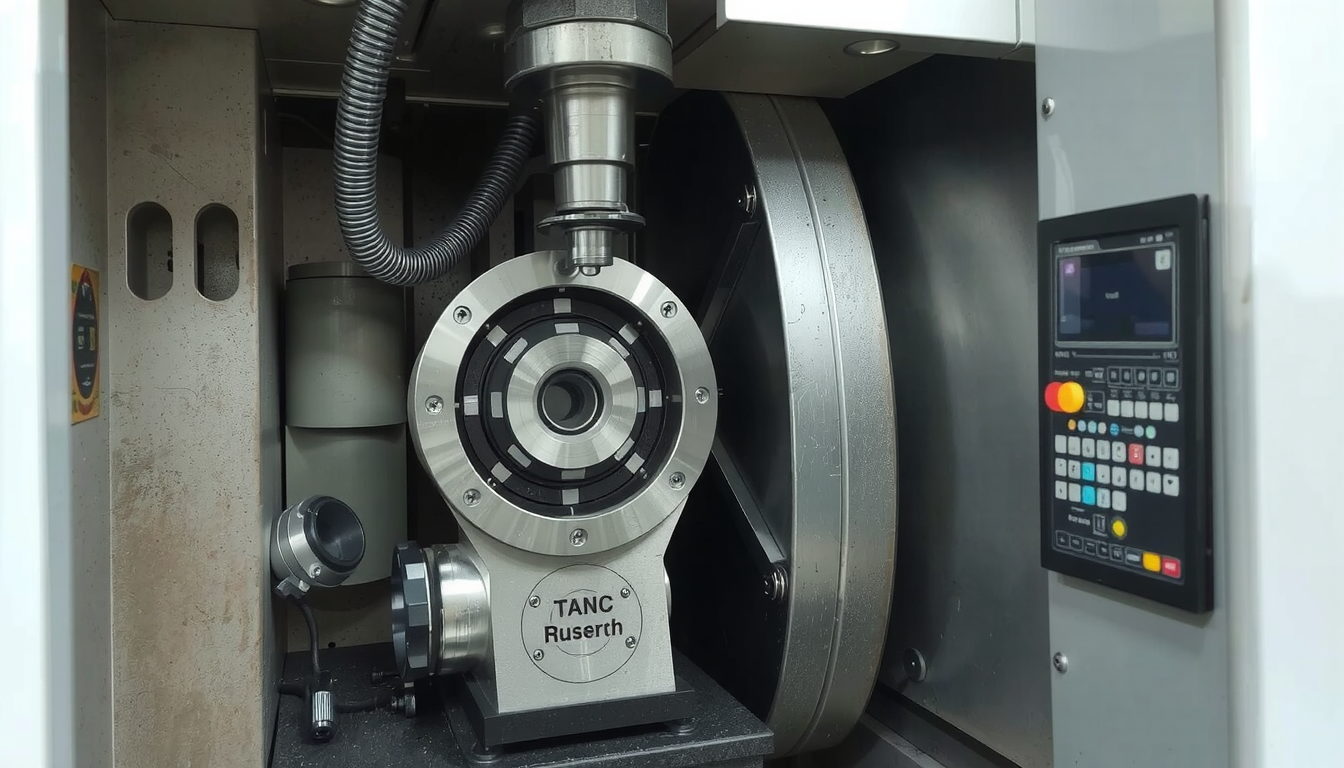CNC milling and turning are key processes in today’s manufacturing. Both use computer controls to cut material from a solid block. They create precise parts. These are subtractive methods. This means they remove material to form a final shape.

The main difference is simple. In CNC turning, the part spins while a fixed tool cuts it. In CNC milling, the tool spins and moves across a fixed part.
This guide will explain both methods in detail. It will give you a clear way to choose the best process for your project. This will save you time and money.
Understanding the Basics: What is CNC Milling?
CNC milling is a very flexible manufacturing process. It uses a rotating tool to cut material away from a still workpiece. This method is perfect for creating many different shapes.
The Milling Process Explained
Think of a sculptor carving a block of stone. The rotating cutter in a milling machine acts like the sculptor’s chisel. It removes material to match a digital design. The full CNC milling process explained involves a few key steps from design to the finished part.
The basic workflow for milling is:
1. Design: A 3D model is created using CAD software.
2. Programming: CAM software turns the CAD model into G-code. This is the machine’s instructions.
3. Machine Setup: A block of material is secured to the machine bed. The correct cutting tools are loaded.
4. Execution: The machine follows the G-code. It cuts the part to the exact specs.
Common Uses and Shapes
CNC milling is used to make parts with flat surfaces, pockets, slots, and complex 3D shapes. It is the go-to process for items that are not mostly round.
Common milled parts include:
* Housings and cases
* Brackets and fixtures
* Engine parts
* Molds and tooling
Understanding the Basics: What is CNC Turning?
CNC turning is a process that creates parts with round features. It is known for its speed. It can produce very smooth surface finishes on round parts.
The Turning Process Explained
Think of a potter’s wheel. In CNC turning, a bar of material is held in a chuck and spun at high speed. A still cutting tool then moves along the workpiece’s surface. It shaves away material to create the desired shape.

This process is done on a machine called a lathe. Some use a more advanced CNC turning service center. While the concept is simple, modern machines are very complex. You can learn more by understanding CNC turning basics. The mix of a rotating part and a straight tool path is perfect for creating round shapes.
Common Uses and Shapes
If your part is round, CNC turning is likely the best place to start. It works great for producing any part with a round or cone-shaped profile.
Common turned parts include:
* Shafts and axles
* Pins and dowels
* Screws and bolts
* Nozzles and fittings
CNC Milling vs. Turning: A Side-by-Side Look
The core difference between CNC milling and turning is motion. But this difference affects part shape, cost, and tooling. Understanding these differences is key to picking the right manufacturing method.
| Criterion | CNC Milling | CNC Turning |
|---|---|---|
| Core Motion | Rotating tool, still workpiece. | Rotating workpiece, still tool. |
| Typical Part Shape | Block-like, complex 3D surfaces. | Round, cone-shaped, circular shapes. |
| Tooling | Multi-point cutting tools. | Single-point cutting tools. |
| Setup Complexity | Generally more complex, may need multiple setups. | Often faster and simpler for basic round parts. |
| Cost for Simple Shapes | Higher for simple round parts. | Lower for simple round parts. |
| Cost for Complex Shapes | More cost-effective for non-round complexity. | Cost increases with non-round features. |
| Achievable Features | Pockets, slots, flat faces, complex contours. | External/internal threads, grooves, tapers. |
| Surface Finish | Good, but can have visible tool paths. | Excellent and smooth on diameters. |
Precision and Tolerances
Both CNC milling and turning are highly precise processes. They can create parts with very tight dimensions. However, turning can often achieve very tight tolerances on diameters with greater ease. On well-kept machines, tolerances of ±0.005 mm or even better are possible for turned features.
Choosing the Right Process: A Practical Decision Guide
Choosing between CNC milling and turning does not have to be hard. By checking your design against a few key questions, you can quickly find the most logical and cost-effective process.
Step 1: Look at the Primary Part Shape
First, look at the overall shape of your part. This is the most important factor.
Ask yourself: Is the part mostly round? If you were to look at it from the end, is it mostly a circle? If the answer is yes, then CNC turning is your starting point. Shafts, pins, and custom fittings are perfect examples.

Or, is the part mostly block-like or does it have complex, freeform surfaces? If so, CNC milling is the right choice. Think of parts like electronic cases, machine brackets, or custom heatsinks.
Step 2: Find Key Features
Next, look at the specific features on the part.
Does your part need external or internal threads on a round profile? Does it have grooves or tapered surfaces? These are classic operations for CNC turning.
Does the part need flat faces, pockets, or holes drilled on a non-round surface? These features are made with CNC milling. Even a simple turned shaft may need a flat area or a keyway. This requires a secondary milling operation.
Step 3: Consider Material and Volume
For simple round parts made in large amounts, turning is almost always more cost-effective. The cycle times are often much faster than milling a similar shape. The material is typically fed from a bar feeder. This allows for continuous, automated production.
Step 4: When Do You Need Both?
Many parts are not purely turned or purely milled. A complex part might start as a turned part to create the main round body. Then, it might be moved to a milling machine to add features like flats, off-center holes, or complex cutouts. This is a common approach for parts that combine round and block-like features.
Beyond the Basics: Combining Milling and Turning for Complex Parts
Modern manufacturing has evolved beyond separate milling and turning machines. Advanced equipment can now combine both processes. This offers incredible efficiency and capability for complex parts. This integrated approach to CNC milling and turning is a game-changer.
What are Mill-Turn Centers?
Mill-turn centers are highly advanced machines that combine the functions of a lathe and a milling machine. They can turn a part at high speed and then use “live tooling” to mill, drill, and tap features. All in a single setup.
The main benefits are:
* Increased Accuracy: The part is not moved between machines. This eliminates errors from re-fixturing.
* Reduced Lead Times: All operations are done in one place. This greatly speeds up production.
* Complex Shapes: Parts that were once impossible to make in a single setup are now routine.

The Role of Swiss-Type Machining
Swiss turning is a specialized form of CNC turning designed for very small, long, and intricate parts. It is common in the medical, electronics, and watch-making industries.
Its unique design uses a guide bushing to support the material right next to the cutting tool. This support prevents the material from bending or vibrating. This allows for very high precision on long, slender parts. Many Swiss machines also include milling capabilities. For small, highly complex parts, exploring Swiss CNC turning services is often the most effective solution.
Designing for Manufacturability: Pro Tips for Milling & Turning
From our experience manufacturing thousands of parts, we’ve learned that a few small design changes can have a big impact on cost and quality. Keeping manufacturability in mind during the design phase is crucial. Here are some pro tips for both CNC milling and turning.
Tips for CNC Turning Designs
Following these guidelines will make your turned parts cheaper and faster to produce. Many of the best practices when designing for CNC turning focus on how the tool interacts with the part.
- Avoid sharp internal corners. Cutting tools have a radius. So design internal corners with a small radius to match.
- Keep wall thicknesses uniform. Thin walls can vibrate or distort during machining. So maintain a consistent thickness where possible.
- Design grooves with standard tool widths. Using non-standard groove widths requires custom tooling. This adds cost.
Tips for CNC Milling Designs
Milling offers great design freedom. But some features are much more expensive to produce than others.
- Design pockets with a corner radius. A good rule of thumb is a corner radius of at least 1/3 of the pocket’s depth. This allows for a stronger, more rigid tool.
- Avoid deep, narrow pockets. These require long, fragile tools that can break easily and must run slowly. This increases machine time and cost.
- Specify tight tolerances only where necessary. Over-tolerancing is one of the biggest drivers of unnecessary cost. Apply tight tolerances only to critical features.
Conclusion: Making the Right Choice for Your Manufacturing Needs
The choice between CNC milling and turning comes down to your part’s shape and features. Let the shape of your part guide your decision.
Turning is for round parts. Milling is for block-like parts. Advanced mill-turn centers offer the best of both worlds for complex parts. Partnering with an experienced machine shop can help you navigate these choices. For expert guidance on your next project, explore our comprehensive CNC machining capabilities.
Frequently Asked Questions
Is CNC milling or turning more expensive?
It depends entirely on the part’s shape. For a simple shaft, turning is much cheaper. For a complex housing with pockets and holes, milling is the only practical option. Its cost is based on the complexity. Using the wrong process for a given shape is always the most expensive choice.
Can you get a smooth finish with CNC milling?
Yes, absolutely. While turning naturally creates a very smooth finish on diameters, milling can also achieve fine surface finishes. This is done using specific tools, like ball-end mills for contoured surfaces. It also uses techniques like high-speed machining with small step-overs. However, achieving a very fine finish may increase machine time.
What materials can be used in CNC milling and turning?
Both processes are very flexible and work with a huge range of materials. This includes metals like aluminum, steel, stainless steel, titanium, and brass. It also includes plastics like ABS, polycarbonate, PEEK, and nylon. Material choice depends on the part’s application requirements, not the machining process itself.
What is the difference between a CNC lathe and a CNC turning center?
A basic CNC lathe primarily performs turning operations. This includes cutting outer and inner diameters, facing, and drilling along the center axis. A CNC turning center is more advanced. It often includes “live tooling” and extra axes. This allows it to perform milling, tapping, and drilling operations off-center, all in the same setup.
How do I prepare a design file for CNC milling or turning?
You should provide your 3D CAD files in a standard format like IGS, STP, or IGES, as these are compatible with most CNC machinists’ software. If your designer is new to creating files for CNC milling and turning, suggest they follow a tutorial to make sure everything is pulled together correctly for manufacturing.

